| Listing 1 - 10 of 10 |
Sort by
|
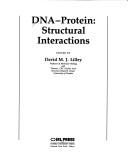
ISBN: 019963453X 0199634548 9780199634545 9780199634538 Year: 1995 Volume: 7 Publisher: Oxford [etc.] : Oxford University Press,
Abstract | Keywords | Export | Availability | Bookmark
 Loading...
Loading...Choose an application
- Reference Manager
- EndNote
- RefWorks (Direct export to RefWorks)
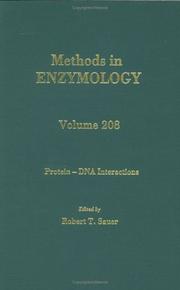
ISBN: 0121821099 9780121821098 Year: 1992 Volume: 208 Publisher: London ; San Diego, CA : Academic Press,
Abstract | Keywords | Export | Availability | Bookmark
 Loading...
Loading...Choose an application
- Reference Manager
- EndNote
- RefWorks (Direct export to RefWorks)
DNA-protein interactions --- DNA-proteïneinteracties --- Interactions ADN-protéine --- DNA-Binding Proteins --- Biological techniques --- Enzymology --- Molecular biology --- DNA --- Proteins --- ADN --- Protéines --- analysis.
Book

ISBN: 9781788019040 9781839163241 Year: 2022 Publisher: Cambridge : ©2022 RSC Publishing,
Abstract | Keywords | Export | Availability | Bookmark
 Loading...
Loading...Choose an application
- Reference Manager
- EndNote
- RefWorks (Direct export to RefWorks)
The structure, function and reactions of nucleic acids are central to molecular biology and medicine and are crucial for understanding of the ever-expanding range of complex biological processes involved which are central to life. Revised, extended, updated and lavishly illustrated, this 4th Edition of Nucleic Acids in Chemistry and Biology is a long-awaited standard text for teaching and research in nucleic acids science. It maintains the close integration of chemistry and biology that characterised the earlier editions and contains a major expansion largely focused on the burgeoning growth of RNA science. Written by an international team of leading experts, all with extensive teaching experience, this 4th Edition provides up-to-date and extended coverage of the reactions and interactions of RNA and DNA with proteins and drugs. A brief history of the discovery of nucleic acids is followed by a molecule-based introduction to the structure and biological roles of DNA and RNA and the basics of Genes and Genomes. New key chapters are devoted to non-coding RNA, nucleic acids sequencing, nucleic acid therapeutics, in vitro evolution and aptamers, and protein-RNA interactions. The text is linked to an extensive list of references to make it a definitive reference source. This authoritative volume presents topics in an integrated manner and readable style with full colour illustrations throughout. It is ideal for graduate and undergraduate students of chemistry and biochemistry, biophysics and biotechnology, and molecular biology and medicine. It will be a guidebook for new researchers to the field of nucleic acids science.
Nucleic acids. --- Genomes. --- RNA. --- RNA-protein interactions. --- DNA-protein interactions. --- Acides nucléiques --- Génome --- ARN --- Interactions ARN-protéine. --- Interactions ADN-protéine.
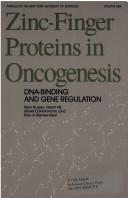
ISBN: 0897667832 0897667840 9780897667845 Year: 1993 Volume: 684 Publisher: New York, NY : New York Academy of Sciences,
Abstract | Keywords | Export | Availability | Bookmark
 Loading...
Loading...Choose an application
- Reference Manager
- EndNote
- RefWorks (Direct export to RefWorks)
Conferences - Meetings --- Zinc-finger proteins --- DNA-protein interactions --- Transcription factors --- Genetic regulation --- Carcinogenesis --- Zinc fingers --- Zinc proteins --- Genetic transcription factors --- Proteins --- DNA-protein binding --- Interactions, DNA-protein --- Protein-DNA interactions --- DNA-ligand interactions --- Protein binding --- Congresses --- DNA-Binding Proteins. --- Zinc-finger proteins - Congresses. --- DNA-protein interactions - Congresses. --- Carcinogenesis - Congresses. --- Transcription factors - Congresses. --- Genetic regulation - Congresses. --- Transcription, genetic
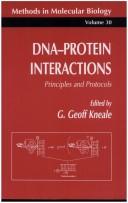
ISBN: 0896032566 1592595170 9780896032569 Year: 1994 Volume: 30 Publisher: Totowa : Humana Press,
Abstract | Keywords | Export | Availability | Bookmark
 Loading...
Loading...Choose an application
- Reference Manager
- EndNote
- RefWorks (Direct export to RefWorks)
The study of protein-nucleic acid interactions is currently one of the most rapidly growing areas of molecular biology. DNA binding proteins are at the very heart of the regulation and control of gene expression, replication, and recombination: Enzymes that recognize and either modify or cleave specific DNA sequences are equally important to the cell. Some of the techniques reported in this volume can be used to identify previously unknown DNA binding proteins from crude cell extracts. Virtually all are capable of giving direct information on the molecular basis of the interaction—the location of the DNA binding site; the strength and specificity of binding; the identities of individual groups on specific bases involved in binding; the specific amino acid residues of the protein that interact with the DNA; or the effects of protein binding on gross conformation and local structure of DNA. The recognition of DNA sequences by proteins is a complex phenomenon, involving specific hydrogen bonding contacts to the DNA bases ("direct readout") and/or interactions with the sugar-phos phate backbone ("indirect readout"). The latter interactions can also be highly specific because of sequence-dependent conformational changes in the DNA. In addition, intercalation of planar aromatic amino acid side-chains between the DNA bases can occur, most notably with single-stranded DNA binding proteins. Furthermore, when bound, many DNA binding proteins induce drastic structural changes in the DNA as an integral part of their function.
DNA-protein interactions --- ADN --- DNA --- Protéine --- proteins --- Acide nucléique --- Nucleic acids --- Protéine de liaison --- Binding proteins --- Synthèse protéique --- protein synthesis --- DNA-protein interactions. --- Electronic books. -- local. --- Protein binding. --- Genetic Techniques --- DNA-Binding Proteins --- Proteins --- Investigative Techniques --- Amino Acids, Peptides, and Proteins --- Analytical, Diagnostic and Therapeutic Techniques and Equipment --- Chemicals and Drugs --- Animal Biochemistry --- Human Anatomy & Physiology --- Health & Biological Sciences --- DNA-protein binding --- Interactions, DNA-protein --- Protein-DNA interactions --- DNA-ligand interactions --- Protein binding --- Binding, Protein --- Biochemistry --- Allosteric proteins --- Radioligand assay --- DNA. --- Biochemistry. --- Biochemistry, general. --- Biological chemistry --- Chemical composition of organisms --- Organisms --- Physiological chemistry --- Biology --- Chemistry --- Medical sciences --- Composition
Book
ISBN: 0387928073 9786612973840 1282973843 0387928081 Year: 2011 Publisher: New York, NY : Springer New York : Imprint: Springer,
Abstract | Keywords | Export | Availability | Bookmark
 Loading...
Loading...Choose an application
- Reference Manager
- EndNote
- RefWorks (Direct export to RefWorks)
This book presents a concise overview of current research on the biophysics of DNA-protein interactions. A wide range of new and classical methods are presented by authors investigating physical mechanisms by which proteins interact with DNA. For example, several chapters address the mechanisms by which proteins search for and recognize specific binding sites on DNA, a process critical for cellular function. Single molecule methods such as force spectroscopy as well as fluorescence imaging and tracking are described in these chapters as well as other parts of the book that address the dynamics of protein-DNA interactions. Other important topics include the mechanisms by which proteins engage DNA sequences and/or alter DNA structure. These simple but important model interactions are then placed in the broader biological context with discussion of larger protein-DNA complexes . Topics include replication forks, recombination complexes, DNA repair interactions, and ultimately, methods to understand the chromatin context of the cell nucleus. This book will be of interest to readers who wish to explore current biophysical approaches to DNA-protein interactions across multiple levels of biological complexity.
DNA-protein interactions. --- DNA-protein interactions --- Molecular biology --- Physical Phenomena --- Proteins --- Phenomena and Processes --- Amino Acids, Peptides, and Proteins --- DNA-Binding Proteins --- Biophysical Phenomena --- Chemicals and Drugs --- Human Anatomy & Physiology --- Biology --- Health & Biological Sciences --- Animal Biochemistry --- Biophysics --- Molecular biology. --- Molecular biochemistry --- Molecular biophysics --- DNA-protein binding --- Interactions, DNA-protein --- Protein-DNA interactions --- Physics. --- Biochemistry. --- Proteins. --- Cell biology. --- Biophysics. --- Biological physics. --- Biomedical engineering. --- Biophysics and Biological Physics. --- Molecular Medicine. --- Cell Biology. --- Biomedical Engineering. --- Biochemistry, general. --- Protein Structure. --- Biochemistry --- Biomolecules --- Systems biology --- DNA-ligand interactions --- Protein binding --- Medicine. --- Cytology. --- Biological and Medical Physics, Biophysics. --- Biomedical Engineering and Bioengineering. --- Biological chemistry --- Chemical composition of organisms --- Organisms --- Physiological chemistry --- Chemistry --- Medical sciences --- Clinical engineering --- Medical engineering --- Bioengineering --- Engineering --- Medicine --- Cell biology --- Cellular biology --- Cells --- Cytologists --- Clinical sciences --- Medical profession --- Human biology --- Life sciences --- Pathology --- Physicians --- Composition --- Health Workforce --- Proteins . --- Proteids --- Polypeptides --- Proteomics --- Biological physics --- Physics
Book
ISBN: 1461450365 1461450373 128386505X 1489998519 Year: 2013 Publisher: New York, NY : Springer New York : Imprint: Springer,
Abstract | Keywords | Export | Availability | Bookmark
 Loading...
Loading...Choose an application
- Reference Manager
- EndNote
- RefWorks (Direct export to RefWorks)
In recent years, a number of groundbreaking structural and mechanistic studies deepened our understanding of helicase mechanisms and established new approaches for their analyses. Many fundamental mechanistic questions ranging from the mechanism of force generation, mechanochemical coupling to distinct mechanisms by which the same enzyme translocates on DNA removing obstacles, unwinds DNA and/or remodels nucleoprotein complexes, however, remain to be answered. It is even less understood how the helicase motors are incorporated into a wide range of genome maintenance and repair machines. The field has reached a stage when the studies of molecular mechanisms and basic biology of helicases can and shall be integrated with the studies of development, cancer and longevity. The objective of this book is to provide the first systematic overview of structure, function and regulation of DNA helicases and related molecular motors. By integrating the knowledge obtained through the diverse technical approaches ranging from single-molecule biophysics to cellular and molecular biological studies the editors aim to provide a unified view on how helicases function in the cell, are regulated in response to different cellular stresses and are integrated into large macromolecular assemblies to form a complex and adaptive living system.
Bacterial genetics. --- DNA helicases. --- DNA polymerases. --- Isomerases --- Adenosine Triphosphatases --- Multiprotein Complexes --- Acid Anhydride Hydrolases --- Enzymes --- Macromolecular Substances --- Enzymes and Coenzymes --- Hydrolases --- Chemicals and Drugs --- Molecular Motor Proteins --- DNA Helicases --- Medicine --- Human Anatomy & Physiology --- Biology --- Health & Biological Sciences --- Animal Biochemistry --- Genetics --- Pathology --- DNA-protein interactions. --- DNA-protein binding --- Interactions, DNA-protein --- Protein-DNA interactions --- Helicases, DNA --- Medicine. --- Human genetics. --- Biochemistry. --- Cell biology. --- Biomedicine. --- Human Genetics. --- Biochemistry, general. --- Cell Biology. --- Biomedicine general. --- Cell biology --- Cellular biology --- Cells --- Cytologists --- Biological chemistry --- Chemical composition of organisms --- Organisms --- Physiological chemistry --- Chemistry --- Medical sciences --- Heredity, Human --- Human biology --- Physical anthropology --- Clinical sciences --- Medical profession --- Life sciences --- Physicians --- Composition --- DNA-ligand interactions --- Protein binding --- Cytology. --- Health Workforce --- Biomedicine, general.
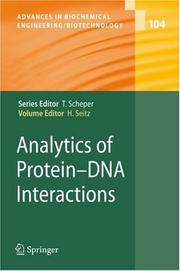
ISSN: 07246145 ISBN: 9783540481478 3540481478 3540481508 9786610727575 1280727578 Year: 2007 Volume: 104 Publisher: Berlin, Heidelberg : Springer,
Abstract | Keywords | Export | Availability | Bookmark
 Loading...
Loading...Choose an application
- Reference Manager
- EndNote
- RefWorks (Direct export to RefWorks)
DNA-protein interactions --- DNA-Binding Proteins --- DNA Footprinting --- genetics --- methods --- chemistry --- Biochemistry --- Biotechnology --- Human genetics --- Medicine --- Microbiology --- Interactions ADN-protéine --- Biology. --- DNA-protein interactions. --- Electronic books. -- local. --- Proteins --- Nuclease Protection Assays --- Genetic Techniques --- Investigative Techniques --- Amino Acids, Peptides, and Proteins --- Chemicals and Drugs --- Analytical, Diagnostic and Therapeutic Techniques and Equipment --- Human Anatomy & Physiology --- Health & Biological Sciences --- Mechanical Engineering --- Engineering & Applied Sciences --- Animal Biochemistry --- Bioengineering --- Biomedical Engineering --- DNA-protein binding --- Interactions, DNA-protein --- Protein-DNA interactions --- Chemistry. --- Medical microbiology. --- Analytical chemistry. --- Biotechnology. --- Genetic engineering. --- Medicinal chemistry. --- Biochemistry. --- Genetic Engineering. --- Biochemistry, general. --- Analytical Chemistry. --- Medical Microbiology. --- Medicinal Chemistry. --- Biological chemistry --- Chemical composition of organisms --- Organisms --- Physiological chemistry --- Biology --- Chemistry --- Medical sciences --- Chemistry, Medical and pharmaceutical --- Chemistry, Pharmaceutical --- Drug chemistry --- Drugs --- Medical chemistry --- Medicinal chemistry --- Pharmacochemistry --- Designed genetic change --- Engineering, Genetic --- Gene splicing --- Genetic intervention --- Genetic surgery --- Genetic recombination --- Transgenic organisms --- Chemical engineering --- Genetic engineering --- Analysis, Chemical --- Analytical chemistry --- Chemical analysis --- Metallurgical analysis --- Mineralogy, Determinative --- Physical sciences --- Composition --- Life sciences --- Biomass --- Life (Biology) --- Natural history --- DNA-ligand interactions --- Protein binding --- Analytical biochemistry. --- Microbiology. --- Microbial biology --- Microorganisms --- Analytic biochemistry --- Chemistry, Analytic --- Bioanalytic chemistry --- Bioanalytical chemistry --- Analytic chemistry
Book

ISBN: 1441906711 144190669X 1441906703 9786612333255 1282333259 1461424526 Year: 2009 Publisher: New York, NY : Springer New York : Imprint: Springer,
Abstract | Keywords | Export | Availability | Bookmark
 Loading...
Loading...Choose an application
- Reference Manager
- EndNote
- RefWorks (Direct export to RefWorks)
Propelled by the success of the sequencing of the human and many related genomes, molecular and cellular biology has delivered significant scientific breakthroughs. Mathematics (broadly defined) continues to play a major role in this effort, helping to discover the secrets of life by working collaboratively with bench biologists, chemists and physicists. Because of its outstanding record of interdisciplinary research and training, the IMA was an ideal venue for the 2007-2008 IMA thematic year on Mathematics of Molecular and Cellular Biology. The kickoff event for this thematic year was a tutorial on Mathematics of Nucleic Acids, followed by the workshop Mathematics of Molecular and Cellular Biology, held September 15--21 at the IMA. This volume is dedicated to the memory of Nicholas R. Cozzarelli, a dynamic leader who fostered research and training at the interface between mathematics and molecular biology. It contains a personal remembrance of Nick Cozzarelli, plus 15 papers contributed by workshop speakers. The papers give and overview of state-of-the-art mathematical approaches to the understanding of DNA structure and function, and the interaction of DNA with proteins that mediate vital life processes. .
Biomathematics -- Congresses. --- DNA -- Congresses. --- DNA -- Structure -- Congresses. --- DNA-protein interactions -- Congresses. --- Biomathematics --- DNA --- DNA-protein interactions --- Mathematics --- Structure-Activity Relationship --- Protein Interaction Mapping --- Pharmacological Phenomena --- Nucleic Acids --- Molecular Probe Techniques --- Biochemical Phenomena --- Natural Science Disciplines --- Chemical Phenomena --- Physiological Phenomena --- Disciplines and Occupations --- Investigative Techniques --- Nucleic Acids, Nucleotides, and Nucleosides --- Chemicals and Drugs --- Phenomena and Processes --- Analytical, Diagnostic and Therapeutic Techniques and Equipment --- Biology - General --- Genetics --- Animal Biochemistry --- Human Anatomy & Physiology --- Biology --- Health & Biological Sciences --- Structure --- Gene mapping --- Biomathematics. --- Mathematical models. --- Structure. --- Chromosome mapping --- Genetic mapping --- Genome mapping --- Linkage mapping (Genetics) --- Mapping, Gene --- Deoxyribonucleic acid --- Desoxyribonucleic acid --- Thymonucleic acid --- TNA (Nucleic acid) --- Medicine. --- Health informatics. --- Systems biology. --- Applied mathematics. --- Engineering mathematics. --- Medicine & Public Health. --- Health Informatics. --- Mathematical and Computational Biology. --- Systems Biology. --- Applications of Mathematics. --- Deoxyribose --- Nucleic acids --- Genes --- Technique --- Medical records --- Biological models. --- Mathematics. --- Data processing. --- Math --- Science --- Models, Biological --- EHR systems --- EHR technology --- EHRs (Electronic health records) --- Electronic health records --- Electronic medical records --- EMR systems --- EMRs (Electronic medical records) --- Information storage and retrieval systems --- Medical care --- Engineering --- Engineering analysis --- Mathematical analysis --- Computational biology --- Bioinformatics --- Biological systems --- Molecular biology --- Clinical informatics --- Health informatics --- Medical information science --- Information science --- Medicine --- Data processing
Book
Year: 2020 Publisher: Basel, Switzerland MDPI - Multidisciplinary Digital Publishing Institute
Abstract | Keywords | Export | Availability | Bookmark
 Loading...
Loading...Choose an application
- Reference Manager
- EndNote
- RefWorks (Direct export to RefWorks)
Disordered proteins are relatively recent newcomers in protein science. They were first described in detail by Wright and Dyson, in their J. Mol. Biol. paper in 1999. First, it was generally thought for more than a decade that disordered proteins or disordered parts of proteins have different amino acid compositions than folded proteins, and various prediction methods were developed based on this principle. These methods were suitable for distinguishing between the disordered (unstructured) and structured proteins known at that time. In addition, they could predict the site where a folded protein binds to the disordered part of a protein, shaping the latter into a well-defined 3D structure. Recently, however, evidence has emerged for a new type of disordered protein family whose members can undergo coupled folding and binding without the involvement of any folded proteins. Instead, they interact with each other, stabilizing their structure via “mutual synergistic folding” and, surprisingly, they exhibit the same residue composition as the folded protein. Increasingly more examples have been found where disordered proteins interact with non-protein macromolecules, adding to the already large variety of protein–protein interactions. There is also a very new phenomenon when proteins are involved in phase separation, which can represent a weak but functionally important macromolecular interaction. These phenomena are presented and discussed in the chapters of this book.
Research & information: general --- Biology, life sciences --- intrinsically disordered proteins --- epiproteome --- disordered protein platform --- molecular recognition feature --- post-translational modifications --- physiological homeostasis --- stress response --- RIN4 --- p53 --- molecular machines --- intrinsically disordered protein --- membrane-less organelle --- neurodegenerative disease --- p300 HAT acetylation --- post-translational modification --- protein aggregation --- Tau fibrillation --- intrinsically disorder proteins --- disorder-to-order regions --- protein–RNA interactions --- unstructured proteins --- conformational plasticity --- disordered protein --- folding --- ribosomal protein --- spectroscopy --- protein stability --- temperature response --- protein thermostability --- salt bridges --- meta strategy --- dual threshold --- significance voting --- decision tree based artificial neural network --- protein intrinsic disorder --- intrinsic disorder --- intrinsic disorder prediction --- intrinsically disordered region --- protein conformation --- transcriptome --- RNA sequencing --- Microarray --- differentially regulated genes --- gene ontology analysis --- functional analysis --- intrinsically disordered --- structural disorder --- correlated mutations --- co-evolution --- evolutionary couplings --- residue co-variation --- interaction surface --- residue contact network --- dehydron --- homodimer --- hydrogen bond --- inter-subunit interaction --- ion pair --- mutual synergistic folding --- solvent-accessible surface area --- stabilization center --- MLL proteins --- MLL4 --- lncRNA --- HOTAIR --- MEG3 --- leukemia --- histone lysine methyltransferase --- RNA binding --- protein --- hydration --- wide-line 1H NMR --- secretion --- immune --- extracellular --- protein-protein interaction --- structural domain --- evolution --- transcription factors --- DNA-protein interactions --- Sox2 sequential DNA loading --- smFRET --- DNA conformational landscape --- sequential DNA bending --- transcription factor dosage --- oligomer --- N-terminal prion protein --- copper binding --- prion disease mutations --- Nuclear pore complex --- FG-Nups --- phosphorylation --- coarse-grained --- CABS model --- MC simulations --- statistical force fields --- protein structure --- intrinsically disordered proteins (IDPs) --- neurodegenerative diseases --- aggregation --- drugs --- drug discovery --- plant virus --- eIF4E --- VPg --- potyvirus --- molten globule --- fluorescence anisotropy --- protein hydrodynamics --- intrinsically disordered proteins --- epiproteome --- disordered protein platform --- molecular recognition feature --- post-translational modifications --- physiological homeostasis --- stress response --- RIN4 --- p53 --- molecular machines --- intrinsically disordered protein --- membrane-less organelle --- neurodegenerative disease --- p300 HAT acetylation --- post-translational modification --- protein aggregation --- Tau fibrillation --- intrinsically disorder proteins --- disorder-to-order regions --- protein–RNA interactions --- unstructured proteins --- conformational plasticity --- disordered protein --- folding --- ribosomal protein --- spectroscopy --- protein stability --- temperature response --- protein thermostability --- salt bridges --- meta strategy --- dual threshold --- significance voting --- decision tree based artificial neural network --- protein intrinsic disorder --- intrinsic disorder --- intrinsic disorder prediction --- intrinsically disordered region --- protein conformation --- transcriptome --- RNA sequencing --- Microarray --- differentially regulated genes --- gene ontology analysis --- functional analysis --- intrinsically disordered --- structural disorder --- correlated mutations --- co-evolution --- evolutionary couplings --- residue co-variation --- interaction surface --- residue contact network --- dehydron --- homodimer --- hydrogen bond --- inter-subunit interaction --- ion pair --- mutual synergistic folding --- solvent-accessible surface area --- stabilization center --- MLL proteins --- MLL4 --- lncRNA --- HOTAIR --- MEG3 --- leukemia --- histone lysine methyltransferase --- RNA binding --- protein --- hydration --- wide-line 1H NMR --- secretion --- immune --- extracellular --- protein-protein interaction --- structural domain --- evolution --- transcription factors --- DNA-protein interactions --- Sox2 sequential DNA loading --- smFRET --- DNA conformational landscape --- sequential DNA bending --- transcription factor dosage --- oligomer --- N-terminal prion protein --- copper binding --- prion disease mutations --- Nuclear pore complex --- FG-Nups --- phosphorylation --- coarse-grained --- CABS model --- MC simulations --- statistical force fields --- protein structure --- intrinsically disordered proteins (IDPs) --- neurodegenerative diseases --- aggregation --- drugs --- drug discovery --- plant virus --- eIF4E --- VPg --- potyvirus --- molten globule --- fluorescence anisotropy --- protein hydrodynamics
| Listing 1 - 10 of 10 |
Sort by
|

 Search
Search Feedback
Feedback About
About Help
Help News
News